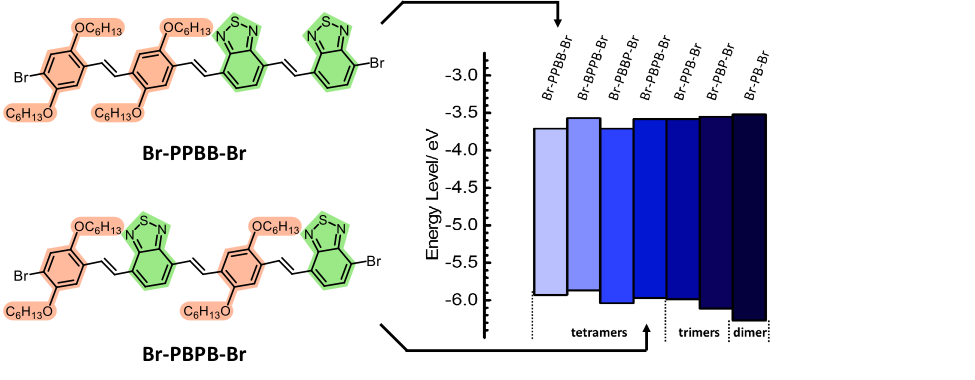Sequence Effects in Donor–Acceptor Oligomeric Semiconductors Comprising Benzothiadiazole and Phenylenevinylene Monomers
Shaopeng Zhang, Nicole E. Bauer, Ilana Y. Kanal, Wei You, Geoffrey R. Hutchison, and Tara Y. Meyer. “Sequence Effects in Donor–Acceptor Oligomeric Semiconductors Comprising Benzothiadiazole and Phenylenevinylene Monomers” Macromol. (2017) 50(1) 151-161. Online
 To understand the influence of monomer sequence on the properties and performance of conjugated oligomers, a series of dimers, trimers, and tetramers were prepared from phenylene (P) and benzothiadiazole (B) monomers linked by vinylene groups. Optical and electrochemical studies established the influence of sequence on both the λmax and redox potentials of this series of structurally related oligomers. For tetramers with bromo end groups (PBBP, BPPB, PBPB, PPBB), the λmax ranged from 493 to 512 nm (Δ = 19 nm), the electrochemical oxidation potential from 0.65 to 0.82 (Δ = 0.17 V) and the reduction potential from −1.45 to −1.31 (Δ = 0.14 V), all of which are sequence-dependent. The effect of end groups (cyano, bromo, and alkyl) was also demonstrated to be important for the properties of these oligomers. DFT calculations of the tetramers were performed and the energy levels were correlated well with the experimentally determined spectroscopic data. Bulk heterojunction (BHJ) solar cells fabricated with selected tetramers as the donor and PC61BM as the acceptor exhibited power conversion efficiencies that varied by a factor of 3 as a function of sequence (0.47–1.85%). These results suggest that sequence control is important for tuning optoelectronic properties and photovoltaic performance of these structurally related conjugated oligomers.
To understand the influence of monomer sequence on the properties and performance of conjugated oligomers, a series of dimers, trimers, and tetramers were prepared from phenylene (P) and benzothiadiazole (B) monomers linked by vinylene groups. Optical and electrochemical studies established the influence of sequence on both the λmax and redox potentials of this series of structurally related oligomers. For tetramers with bromo end groups (PBBP, BPPB, PBPB, PPBB), the λmax ranged from 493 to 512 nm (Δ = 19 nm), the electrochemical oxidation potential from 0.65 to 0.82 (Δ = 0.17 V) and the reduction potential from −1.45 to −1.31 (Δ = 0.14 V), all of which are sequence-dependent. The effect of end groups (cyano, bromo, and alkyl) was also demonstrated to be important for the properties of these oligomers. DFT calculations of the tetramers were performed and the energy levels were correlated well with the experimentally determined spectroscopic data. Bulk heterojunction (BHJ) solar cells fabricated with selected tetramers as the donor and PC61BM as the acceptor exhibited power conversion efficiencies that varied by a factor of 3 as a function of sequence (0.47–1.85%). These results suggest that sequence control is important for tuning optoelectronic properties and photovoltaic performance of these structurally related conjugated oligomers.